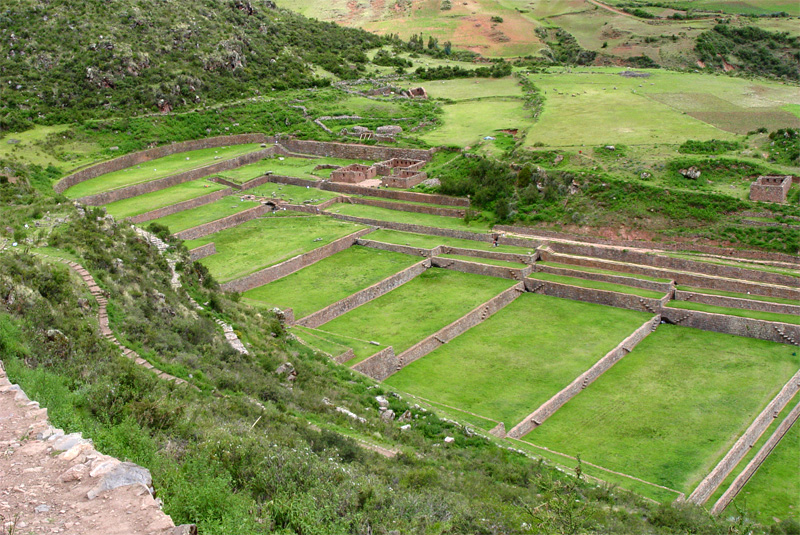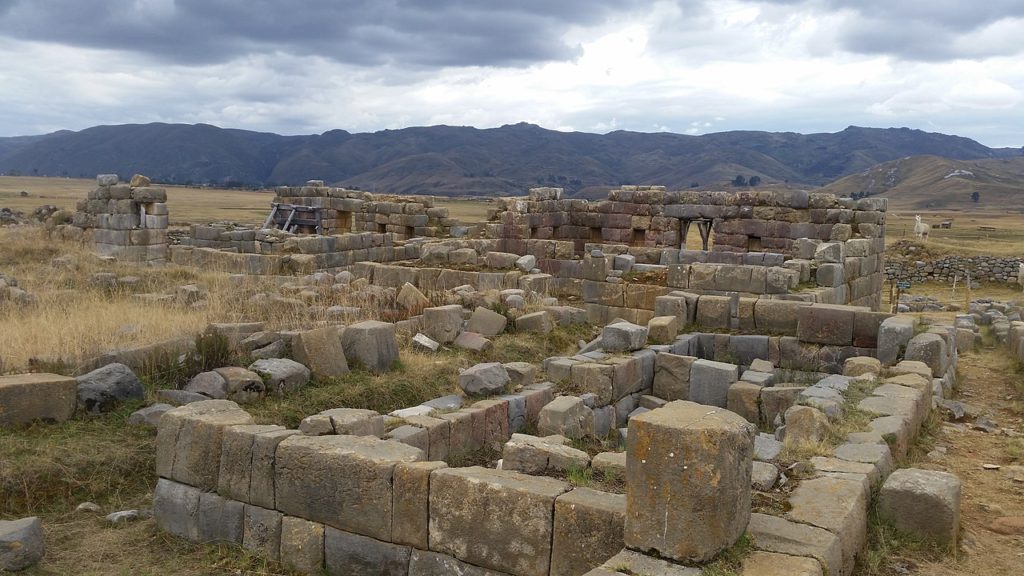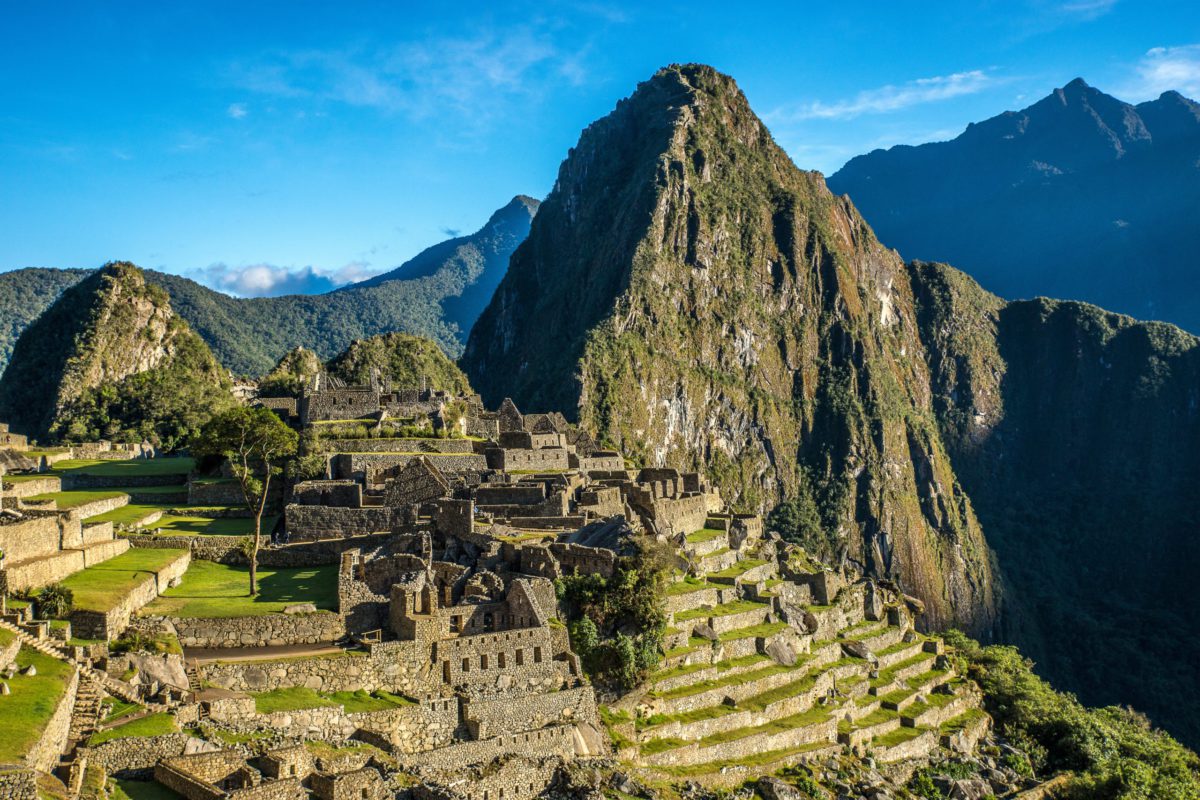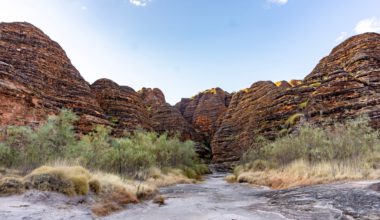The Inca Empire was the largest empire in pre-Colombian America. Their civilization flourished from roughly 1200 A.D. until the mid-1500s when the Spanish arrived and invaded the area and its people. Learn about the top 10 Inca ruins in Peru and start making travel plans to explore these must-see places.
Machu Picchu
Machu Picchu is the most well-known of the Inca ruins in Peru and was labeled one of the new seven wonders of the world. The site is perched high atop a cliffside in the Andes Mountains, sitting 2,350 meters above the Urubamba River. The Incas built this incredible estate around 1450 A.D. but abandoned it before the start of the 17th century. While much is still unknown about this palatial city, many historians believe it was built for the Incan Emperor Pachacuti.
The site was famously rediscovered in 1911. Much work has been done to preserve the area for historical purposes and tourism. You can access the site from the town of Aguas Calientes down below or hike the Inca Trail and camp along the road once traveled by ancient explorers. During your time here, make sure to check out the Sacred Rock and hike up to the Sun Gate for a stellar view of the entire citadel.
Ollantaytambo
Ollantaytambo is a small village in the Sacred Valley tucked between the Andes Mountains and the Urubamba River. Within the site itself, you’ll find cobblestone roads, small stone structures, and large terraces on the mountainside. It was originally constructed for religious purposes, but it’s believed the town was rebuilt around 1450 A.D. by Emperor Pachacuti. Eventually, this site fell to the Spanish forces. It was one of the last remaining Incan cities that fought to hold its place in Peru’s indigenous history.
There is much to see at this ancient site, as it features the Pinkuylluna storehouses, mountain terraces, various fountains and irrigation systems, the Sun Temple, sacred niches, and the Six Monoliths. Take your time and wander through this majestic place of history and mystery.
Sacsayhuamán
Sacsayhuamán is a Quechua word that translates to “place where the hawk is satiated” and or “home of the falcon”. It’s the largest Incan site known to date. Archeologists believe construction started around 1438 A.D. and was inhabited by the Incans until the Spanish invaded in 1533 A.D. The fortress was built in a zigzag pattern with towering walls to keep out intruders. It contains many warehouses, shrines, and temples. Archeologists say what we see now is only 40 percent of its original structure.
When visiting the site, take note of the intricate stonework with airtight seals and massive slabs that were moved 20 kilometers to this spot. No mortar was used by any of the Inca people! Sacsayhuamán is also still utilized today in the form of ceremonies and cultural demonstrations that tourists can experience. Book a tour and explore the majesty of these Inca ruins.
Pisac
Reaching over 3,000 meters into the sky is the archeological site of Pisac. These Inca ruins in Peru feature 40 mountain terraces, 20 towers, plazas, temples, and the Intihuatana, which many believe to be a sundial. Historians feel Pisac’s location was ideal, not only for its positioning to the Urubamba River and the jungle but as a means of defense against attacks on Cusco. It’s also believed that this was another site conquered by Pachacuti who built upon this area that was already inhabited by pre-Inca tribes.
When exploring this sacred land, be sure to look up high in the cliffs. You’ll see what appears to be tunnels or holes. They are actually burial tombs that contain human remains and treasures. And hey, don’t forget the altitude. It’s a long way up but well worth the effort!
Tipón

The Inca ruins of Tipón are perched over 3,000 meters high in the mountains. The city is enclosed by a wall and contains terraces, residential structures, hydraulic water canals, a solar observatory, fountains, and petroglyphs. Many believe Pachacuti or his son built this magnificent place in the early 1400s. However, there is much evidence to support there were pre-Inca groups living here long before.
Tipón is a well-preserved site that’s less crowded than the more popular Inca ruins in Peru based on its location. Come here to relax, explore the beautiful structures, and see the intricacies of the water channels still used today. You can either hike to the top or pay a taxi to take you the majority of the way.
Moray
There are no other Inca ruins quite like Moray. This site contains a series of circular terraces that extend into the ground creating what looks like an amphitheater. Moray features an irrigation system and the remnants of various plant life, which gives scholars insight into its use. However, much is left to the imagination, as there is no written history that confirms Moray’s purpose.
Some believe it was used as an agricultural research facility where the locals would try farming various types of crops throughout the year. This hypothesis is based on the fact that each layer of the circle offers a different temperature, as there is a 15°C difference between the top and bottom layers. It’s clear the Incas used this space to farm but the circular patterning and location are still up for debate.
Choquequirao
The Choquequirao citadel sits high up in the mountains on land that was leveled hundreds of years ago. Choquequirao translates to “crib” or “cradle of gold”, and it seems that’s exactly what the site reflects. Historians believe Pachacuti and his son added on to an existing village in the 15th century and transformed it into a residential space. Many feel this site was home to political and administrative business, while still honoring the gods with temples for worship. Walking the grounds, you’ll find warehouses, dormitories, and mansions for respected officials. Be sure to look out for the white stone figures embedded in the terraces!
While Choquequirao is now a place to learn about the past, it was once the last refuge for the Incas, as their land and people were invaded by the Spanish. To enjoy this ancient treasure, you’ll have to hike and camp along the way as this spot cannot be accessed by roadways. If you’re up for the journey, hire a local guide to help you get there safely.
Wiñay Wayna
If you’re adventurous enough to hike along the Inca Trail to Machu Picchu, then you’ll get to see a lesser-traveled Inca ruins site called Wiñay Wayna. The site mirrors many of the structures found at Machu Picchu, including mountain terraces that overlook the Urubamba River, houses, and fountains. Wiñay Wayna is Quechua for “forever young” and it seems that sentiment is what you’ll feel along this passage through time. While there is evidence of religious practice and ritual at this site, many historians wonder if Wiñay Wayna was simply a resting place along the 40-kilometer journey.
During your stay, observe the clouds rolling in over the mountaintops, listen to the far-off waterfalls, and reflect on the hard work the Incas faced as they created this masterpiece on the side of a cliff.
Qoricancha
Qoricancha is located in downtown Cusco. Its original purpose was a temple to the sun god Inti, but the Spanish pillaged the building and built a church on its foundation. Like many of the other incredible Inca ruins in Peru, Qoricancha was rebuilt by Pachacuti with ornate designs, gold finishings, and shrines. This site was a pilgrimage destination for many Inca citizens and leaders.
Today, you’ll find the colonial-era church of Santo Domingo at this location, but as you tour the grounds, you’ll see the remnants of the Inca Empire that the Spanish were unable to erase. It’s easy to see the distinction between the incredible Incan stonework and the more modern architecture that lies atop this sacred space.
Huánuco Pampa

Huánuco Pampa was another administrative and political center of the Incas, located in the middle of an important trade route along the Inca highway. Built around 1460 A.D., this location contained 500 storehouses for food and other goods to be bought, sold, and bartered along the 40,000-kilometer road.
Historians believe this site was abandoned by 1539 A.D. when the Spanish arrived and conquered the area. What’s left is a clear view of the past of this epic empire. Explore this beautiful site with its remaining square, the main palace, baths, and incredible craftsmanship. And don’t worry about the tourists. Because of its secluded location, you’ll have all the space and time you need to get the perfect pictures.
About TourHero
TourHero is a social travel platform that enables you to travel with like-minded people and fall in love with the journey. We work closely with handpicked local operators to ensure every experience curated is unique and exclusive to your travel group. Come with us on epic adventures and create memories that last a lifetime. Get started here!










